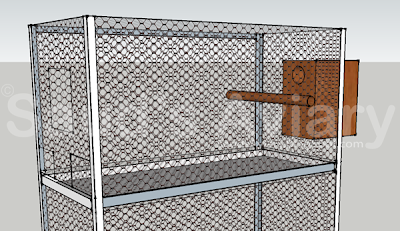Alexandrine Mutations Project: Year 1 (2011)
I have written a few articles on breeding Alexandrine mutations including the Lutino and Blue mutations. These articles were based on internet research and my own knowledge of genetics. I practically started working on this project in Aug 2010 by paring a normal Alexandrine male to an Albino Indian ring-neck hen. This allows me to get started on both the blue and lutino mutations simultaneously. All chicks from this pairing will be useful in the next generation. The males will be useful for the lutino project and the females for the blue Alexandrine project.
The hen was bred in Jan 2009 from a blue ringneck pair where the cock was split to ino. She was hand raised from 3 weeks old and was a tame bird when weaned. I wanted to keep her as a breeder and stopped handling her soon after weaning. She still does not fear humans like other birds and always comes close to me during feeding time. The male was purchased in July 2010 as a young adult approximately two year old with his neck ring not yet complete. The neck ring was still forming and broken at several places.
The hen had matured early and looked eager to breed at 1 year of age. She would come to the front portion of her cage and assume a mating position at feeding time. I was therefore hopeful that she was going to bond with the male quickly. The hen was the dominant bird as she was more confident of the surroundings having grown up in my aviary. This neutralized the size advantage that the male had over her. She was not overly aggressive though. Her dominance meant that she would have her pick in the food dish first. She was also the boss of the perch. They did not show any early signs of bonding. The hen continued to flirt with me at feeding time. She started her first clutch on Jan 7, 2011. The pair were still quarreling at this time. I was not very hopeful that the eggs would be fertile. Sure enough, all 6 eggs in the clutch were clear. I was a little disappointed but there was still time left in the season. I removed the eggs and hoped for another clutch. The pair now started showing signs of bonding, roosting together at night and the male feeding the female. The second clutch was started on March 23, 2011. This time the male was allowed inside the box and I was now getting excited about the prospects. A total of 4 eggs were laid. I did not bother the pair for a couple of weeks and then candled the eggs. Sadly, all 4 eggs were again clear. I removed the eggs and moved the pair to my ringneck flight for the summer. This was the end of Season 1. Not much success but given the fact that both birds were first time breeders the failure was not a big surprise.
The hen was bred in Jan 2009 from a blue ringneck pair where the cock was split to ino. She was hand raised from 3 weeks old and was a tame bird when weaned. I wanted to keep her as a breeder and stopped handling her soon after weaning. She still does not fear humans like other birds and always comes close to me during feeding time. The male was purchased in July 2010 as a young adult approximately two year old with his neck ring not yet complete. The neck ring was still forming and broken at several places.
The hen had matured early and looked eager to breed at 1 year of age. She would come to the front portion of her cage and assume a mating position at feeding time. I was therefore hopeful that she was going to bond with the male quickly. The hen was the dominant bird as she was more confident of the surroundings having grown up in my aviary. This neutralized the size advantage that the male had over her. She was not overly aggressive though. Her dominance meant that she would have her pick in the food dish first. She was also the boss of the perch. They did not show any early signs of bonding. The hen continued to flirt with me at feeding time. She started her first clutch on Jan 7, 2011. The pair were still quarreling at this time. I was not very hopeful that the eggs would be fertile. Sure enough, all 6 eggs in the clutch were clear. I was a little disappointed but there was still time left in the season. I removed the eggs and hoped for another clutch. The pair now started showing signs of bonding, roosting together at night and the male feeding the female. The second clutch was started on March 23, 2011. This time the male was allowed inside the box and I was now getting excited about the prospects. A total of 4 eggs were laid. I did not bother the pair for a couple of weeks and then candled the eggs. Sadly, all 4 eggs were again clear. I removed the eggs and moved the pair to my ringneck flight for the summer. This was the end of Season 1. Not much success but given the fact that both birds were first time breeders the failure was not a big surprise.



Aoa.bhai pls explain how males will b help ful in lutino alex
ReplyDeleteHi Sami, can you tell me what's happened after, I sew the next and they in second year had 3 chicks, what's happened with this 3 chicks, did u started to breed them in second generation?
ReplyDeletePlease see this page for updates, most recent first.
ReplyDeletehttp://saudsaviary.blogspot.com/search/label/AMP